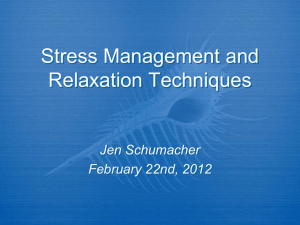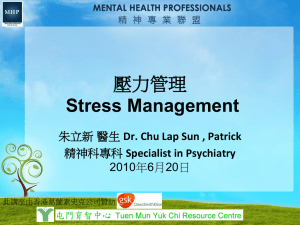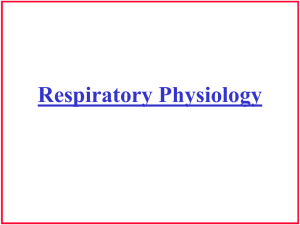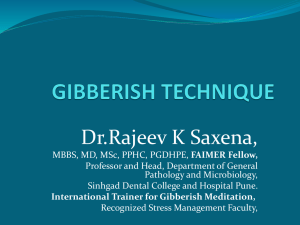T1rho_physics - Center for Magnetic Resonance and Optical
advertisement
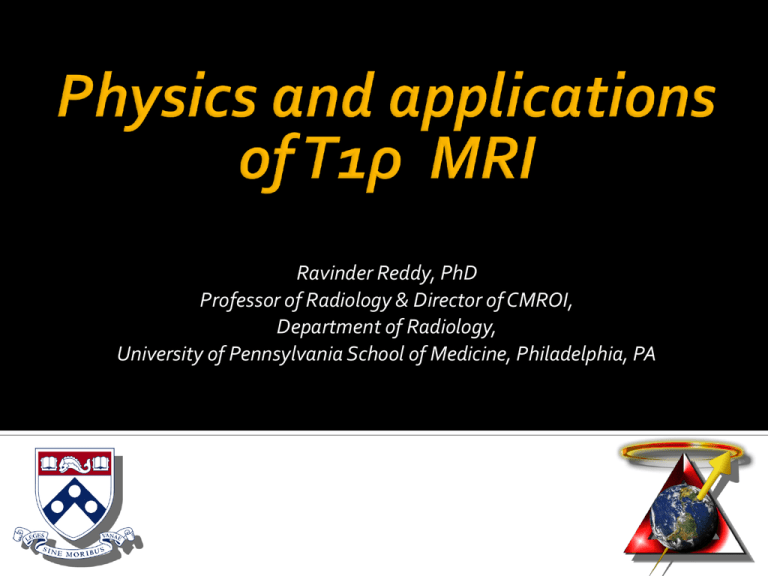
Ravinder Reddy, PhD
Professor of Radiology & Director of CMROI,
Department of Radiology,
University of Pennsylvania School of Medicine, Philadelphia, PA
Outline
Nuclear spin relaxation
T1 and T2
▪ Spectral density
▪ Defining equations, Frequency dependence
T1ρ relaxation
Definition and pictorial illustration
▪ Defining equation, Frequency dependences
▪ Methods of measurement
▪ Contributing mechanisms and image contrast
Chemical exchange, D-D interaction, relaxation
Applications in the study of collagen rich tissues
CMROI
Slide 2
Thermal equilibrium?
How is the thermal equilibrium established?
dMz/dt = -(Mz-Mo)/T1
dMxy/dt = -(Mxy)/T2
Bo =0
CMROI
Bo = 1.5T
Slide 3
T1 and T2
wo
60 MHz
CMROI
Slide 4
T2 Process
Fluctuating fields (Hz) which perturb the energy levels of the
spin states cause transverse magnetization to dephase
E=Bo
Observed line = 1/2 = 1/T2*
1/T2* = 1/T2 + Bo/2
CMROI
Slide 5
Relaxation Mechanisms
Motion of nuclear magnetic moments generates
fluctuating magnetic fields
H= iHx +jHy+kHz
M= iMx + jMy +kMz
(magnetization vector)
Interaction between them
(H x M)= i(HyMz-HzMy)+j(HzMx-Hx Mz) +k(HxMy-HyMx)
Hx,y ----> T1 and T2 relaxation
Hz ----> T2 relaxation
-----> T1>T2
CMROI
Slide 6
Fluctuating fields and spectral
densities
z
Fluctuating fields have
zero average:
<Bx(t)> = 0
Mean square fluctuating
field <Bx2(t)> ≠0
CMROI
x
Bo
Bx
My
y
Slide 7
Correlation time
Comparison of field at any one time point t with its value at
t+
If ‘’ is small compared to the
timescale of the fluctuations, then
the values of the field at the two
time points tend to be similar.
If ‘’ is long, then the system loses
its memory.
CMROI
Slide 8
Fluctuating fields
How rapidly do the fields fluctuate?
Autocorrelation function of the field
(convolution of a function with itself) defined
as:
G(t) = <Bx(t) Bx(t+τ)>≠ 0
CMROI
It tells us how self similar a function is
Slide 9
Autocorrelation function G(t)
An exponential form is assumed:
G(t)= <Bx2> exp(-|t|/tc)
G(t) is large for small values of t, and tends
to zero for large values of t.
‘c’ is known as correlation time of the
fluctuations.
It indicates how long it takes before the
random field changes sign.
CMROI
Slide 10
Spectral density J(ω)
Spectral density function(SDF) is
defined as the 2 FT of G(t):
∫
J( ) = 2 o
∞ G(t) exp{-i t}
For G(t)= <Bx2> exp(-|t|/c)
The spectral density is given
J( ) = 2 <Bx2> c/(1+ 2 c 2)
Normalized SDF:
J( 0) = c/(1+ 2 c 2)
If tc is short then the SDF is broad and
vice versa
Levitt, Spin dynamics
CMROI
Slide 11
Spectral density
As the solution gets more
viscous the number of
molecules with high frequency
components decreases.
J( )
Viscosity of Tissues vary
significantly.
Biological tissues have
different T1s.
SDF also varies with temp.
o
CMROI
log( )
Slide 12
Rotational Motion
CMROI
Slide 13
Dipole-dipole relaxation
For spins-1/2, the important relaxation
mechanism is through space dipolar coupling:
Rotational correlation time τc
1/T1= (3/10)b2{J(ωo)+ 4J(2ωo)}
1/T2= (3/20)b2{3J(0)+ 5J(ωo)+ 2J(2ωo)}
▪ b= (μohγ2/4πr3)
J(ωo)= τc/{1+ (ωoτc)2}
CMROI
Slide 14
T1 and T2
Variation of relaxation
time of protons in water
as a function of
correlation time at a
resonance frequency of
100 MHz (1/ o = 10-8 s)
o c < 1, T1=T2
o c ≥ 1, T1>T2
CMROI
Slide 15
Frequency range probed
T1 probes molecular motional processes in MHz
range
To measure the processes in <MHz to kHz
experiments at Bo fields corresponding to <MHz
Implies low SNR and compromised contrast
T1ρ measures low frequency processes while
performing the measurements at high Bo
T1ρ dispersion can be measured at the constant B0
CMROI
Slide 16
What is T1ρ?
Z
X
o
Y
1
~kHz
60 MHz
CMROI
Slide 17
T1ρ : Spin-locking
/2
TSL
1
Rot, CE, DD
•
•
Redfield, Phys Rev. 98 (1955)
CMROI
time
Spin locking RF pulse prevents normal
T2 relaxation process due to dipolar
interaction etc.
T is primarily determined by the
presence of low frequency motions
Slide 18
T1ρ relaxation and dispersion
For a fixed 1, collect an image (or FID) as a
function of TSL
Sig (TSL)= A exp(-TSL/T )+c
(/2)x
(TSL)y
Relaxation
CMROI
T variation as a function of 1 is
known as T dispersion
(/2)x
(/2)-x
(/2)-x
R
e
R
e
a
d
a
d
(TSL)y
Dispersion
Slide 19
Mechanisms that contribute to T1ρ
dispersion
Rotational motion of a fraction of water
bound to proteins
Exchange of protons on macromolecules with
bulk water
Scalar relaxation
Exchange of -OH, -NH, NH2 with bulk water
CMROI
Non averaged residual dipolar interaction
(RDI)
Diffusion through field gradients
Slide 20
Mechanisms for T1ρ Relaxation
Bo
θ
A
Molecular Rotation
CMROI
Chemical Exchange
B
r
Residual dipole-dipole
Diffusion through Magnetic
Field Gradients
Slide 21
Relaxation rates in biological
tissues
+RDI
+RDI
b= fraction of bound water, C= diffusion contribution
e= water proton exchange time, r= rotational correlation time
B= ( oh2/4r3)2
CMROI
Slide 22
T1ρ and chemical exchange
CMROI
Slide 23
Chemical Exchange
Solute Pool
(with exchangeable proton)
Water Pool
O
H
O
ksw
kws
CMROI
H
H
O
H
H H
O
O
H H
O
H H
H
H
O
H
H
H
O
H
H
Slide 24
Chemical exchange and T1ρ
CMROI
GABA amine protons
Exchange rate ~1.5kHz
Slide 25
Quantify spin-exchange from T1ρ
MRI
Readout
Readout
CMROI
Slide 26
GABA: Exchange of Amine protons
and T1ρ
GABA
CMROI
Slide 27
GABA CEST and T1ρ
CMROI
~18%
~36%
Slide 28
Spin exchange in cartilage and T1ρ
CMROI
Slide 29
Aggrecan and Proteoglycans
HA
Core protein
Glycosaminoglycans (GAG)
G1 G2
Keratan sulfate
rich sections
G3
Chondroitin sulfate
rich sections
G1 G2
Fixed Negative Charge (FCD)
G3
COO-
HO
O
O
O
NHCOCH3
O
OH
CMROI
CH2OSO3 -
OH
Slide 30
Chondroitin Sulfates
Chondroitin-4sulfateCH2O
COO
-
O
O
H
-
NHCOCH
3
O
H
H
Chondroitin-6sulfateCH2OSO3
COO
O
H
O
-
H
O
O
O
O
H
CMROI
O
O3SO
O
O
H
H
O
O
H
H
H
-
H
O
H
O
H
NHCOCH
3
H
H
O
Slide 31
CS phantom images
Regatte et al, JMRI, 17(2003)
CMROI
Slide 32
T1ρ Maps of Cartilage Specimen
256 ms
Articular Surface
Subchondral
Bone
0ms
Normal
Enzymatically Degraded
Akella et al, MRM,46(2004)
CMROI
Slide 33
T1r imaging of chondromalacia
Preliminary results from an osteoarthritic subject diagnosed (arthroscopically) with grade I
chondromalacia in the lateral facet of the patella. The left hand side figure shows the 3D Tr
relaxation map of the patellar cartilage. The color scale shows a volume rendered
representation of Tr relaxation times.
CMROI
Slide 34
T1ρ and dipolar interaction
Bo
θ
A
CMROI
B
r
Slide 35
Static dipolar interaction
Spins with no D-D interaction
Without spin-lock
During spin-lock
ωD
CMROI
Slide 36
Dipolar interaction
CMROI
H= A(1-3 cos2θ)[3Iz2-I(I+1)]
‘θ’ is the angle between the
main Bo field and the dipolar
vector
Dipolar interaction broadens
the resonance lines
Variation in orientation and
content of collagen leads to
different degree of line
broadening in cartilage zones
B0
Slide 37
Arrangement of collagen in
cartilage
Superficial
Middle
Radial
Calcified
CMROI
Slide 38
Effect of RDI on MRI of cartilage
T2
Signal is insensitive to small
changes in PG
Produces “laminar”
appearance
Difficult to interpret image
contrast and maps
CMROI
How do we reduce its effect?
Slide 39
Parallel to B0 - Images
T2
250 Hz
500 Hz
1 KHz
2 KHz
B0
Akella et al, MRM,46(2004)
CMROI
Slide 40
Effect of spin-lock pulse on RDI
T2
250 Hz
T2 = 32 ms T = 62
CMROI
500 Hz
T = 76
1 KHz
T = 86
2 KHz
T = 109
Slide 41
Profile plots (|| to B0)
T1 -2 kHz
T2
T1 -500
T1 -250
Articular
surface
Bone
0
5
10
15
20
25
30
35
Pixel Number
T2
CMROI
250
Hz
500
Hz
2
KHz
Slide 42
Profile plots (magic angle)
T1 -2 kHz
T2
T -500Hz
Articular
surface
0
5
10
Bone
15
20
25
30
35
Pixel number
CMROI
Slide 43
T1ρ dispersion
parallel
54.7o
Akella et al, MRM,46(2004)
CMROI
Slide 44
Reducing laminar appearance
T2 weighted image
T1ρ weighted image (500Hz)
1/T = (1/T )ex+ (1/T )rot + (1/T )RDI+..
CMROI
Slide 45
T1ρ and Sodium MRI of Intervertebral Disc
Healthy 26 yo male
T map
CMROI
Sodium map
Symptomatic 24 yo male
T1rho
scale bar
in ms
Sodium
scale bar
in mM
T map
Sodium map
Slide 46
T1ρ dispersion in Myocardial Infarct
ν1 = 0 Hz
ν1 = 2 kHz
Field Artifacts
Proton Dipole-Dipole Coupling in Collagen
Chemical Exchange On/Off Amide and Hydroxyl
Molecular Rotation of Water Protons
CMROI
Slide 47
B1-dependent relaxation times
T2-weighted
infarction scar
T1ρ-weighted
0
1
2
B1 (kHz)
CMROI
Slide 48
T1ρ Dispersion
CMROI
Slide 49
T1ρ dispersion and Tumor
A and B: T2 and T1ρ weighted
C and D: T2 and T1ρ maps
CMROI
Comparison of the T2 and T1 relaxation time
constants (in ms) between MDA-MB-468 (N=2, open
symbols and dashed lines) and more metastatic MDAMB-231 tumors (N=3, solid symbols
and solid lines).
Slide 50
T1ρ pulse sequence developments
Original: T1ρ pulse cluster pre-encoded to a
2D single slice readout
3D SLIPS sequence:
Enables 3D T1ρ map in <10 minutes
CMROI
Addressed issues of Bo and B1
inhomogeneity
SL-SSFP: new pulse sequence with reduced
SAR for T1ρ MRI @ 7T
Slide 51
T1ρ Imaging- Pulse Sequence
FREQ
PHASE
SLICE
(/2)
(/2)x
(/2)
(/2)-x
SLP
1H
CMROI
RF
TSL
Slide 52
SLIPS pulse sequence
Enables Rapid T1 mapping
3D T1 mapping (30 slices) in about 10 min
Newer version ----> ~5 min
CMROI
Slide 53
B1 and ΔBo insensitive spin-lock
cluster
Witchey et al, JMR 186 (2007)
CMROI
Slide 54
SL-SSFP pulse sequence
Witschey et al, MRM, 2009
CMROI
Slide 55
T1ρ Characteristics
Sensitive to processes at or around the time scale ~ 1/ω1.
Low frequency (Hz-kHz) molecular motions can be probed at
high Bo.
Applying spin-lock pulse:
Reduces B0 inhomogeneities, susceptibility and diffusion-related
signal loss
Increases dynamic range of MRI signal
Ability to measure and minimize
▪ spin-exchange
▪ exchange dependent pH changes
▪ dipolar coupling effects
sensitive to small changes in macromolecular content
CMROI
Slide 56
Acknowledgements
Work was supported by
NIH grants:
R01-AR045242 (RR)
R01-AR045404 (RR)
R01-AR051041 (RR)
RR02305 (RR)
Arthritis Foundation (RR)
Wyeth Research (RR)
OA Spine (AB)
•
•
CMROI
Ari Borthakur
Walter Witschey
Andy Wheaton
Dharmesh Tailor
Erik Shapiro
Eric Mellon
Michael Wang
Feliks Kogan
David Pilkinton
Anup Singh
Victor Babu
Harris Mohammad
Kejia Cai
H. Ralph Schumacher
J. Bruce Kneeland
Hari
Jess Haran
H. Lonner
Mark
JesseElliott
Khurana
Jay Udupa
Slide 57
Thank you!
Thanks for your patience
CMROI
Slide 58
